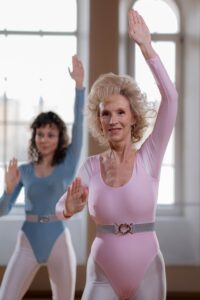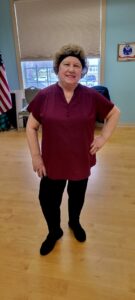By Sharon Longo, Contributing Writer

REGION – Whether it’s a memory of a class, a crowded nightclub, or a relative’s wedding, we’ve probably all danced at one time or another. It may have been with hesitant trepidation, moving to the back of the dance floor to follow along with the Electric Slide, or with the confidence and charisma of Travolta in “Saturday Night Fever.” In either scenario, dancing is a great way to get the blood flowing, raise your spirits, and also enjoy the social aspects.
Physical benefits
While swaying to a classical composition or gyrating to a reggae rhythm or disco beat, research has shown that dance has a number of benefits.
For obvious reasons, keeping the body moving can help to improve fitness. Depending on the type of dance, some genres provide more of an aerobic workout than others. Hip-hop can burn more calories than doing the fox-trot or tango, and ballet, jazz, tap, polka, and disco are somewhere in between.
Dance has been shown to improve physical fitness, while it may also help to lower blood glucose and cholesterol levels.
According to the Department of Health and Human Services’ Physical Activity Fact Sheet for Older Adults, anything that gets your heart beating faster counts as moderate-intensity aerobic activity. This should be done for at least 150 minutes per week with at least two days per week of muscle-strengthening activities that make the muscles work harder.
There are specific dance classes for people with Parkinson’s, and studies done in regard to the tango showed the dance targeted impairments such as walking backward and starting/stopping gait. While comparing the Argentine tango with the waltz and foxtrot, improvements were shown in locomotion, motor control, balance, and freezing of gait in both groups, but more significantly in the tango group.
Dance is said to utilize the three planes of the body: the coronal or frontal, separating the front from the back; the sagittal or longitudinal, separating the right from the left; and the transverse or axial, separating the upper half from the lower half. This leads to better balance and strength, which could possibly prevent a fall.
Social aspects

“Keeping your mind and body active while having a good time is what it is about,” says Clara Sanborn, a line dancing instructor at the Agawam Senior Center.
Photo/Submitted
Because we join others on the dance floor or dance with a single partner, the social aspect of dancing is positive and can lead to better emotional well-being. That opportunity to socialize while enjoying some good music has been shown to reduce depression symptoms in older adults.
Who hasn’t enjoyed the camaraderie and laughing along with others on the dance floor? Whether it’s participating in a line dance, or joining hands to circle around the married couple or clapping for the solo dancer as they take their turn to show off their moves?
Dance doesn’t exclude anyone; if someone were unable to walk, they could still use their upper body to move to the music.
“Dancing is more than just fun,” said Clara Sanborn, a line dance instructor who teaches classes each Monday at the Agawam Senior Center. “Keeping your mind and body active while having a good time is what it is about. The friendships we make continue to let us socialize in later years and combat isolation and loneliness,” she noted. “We support one another and look forward to staying active together. We laugh, smile, and just have fun!”
Mental health and memory
According to Psychology Today magazine, dance therapy or dance/movement therapy may be used for people of all ages to help treat various conditions, mental health disorders, and other challenges including depression, PTSD, and anxiety. Even without the treatment component, the movement and expression alone can help reduce stress, possibly lead to better sleep, and improve one’s mood and energy level.
The brain and body connection in learning and remembering the various dance movements helps with cognitive aspects. Some studies have shown that the areas of the brain such as the frontal lobe, which helps with organizing and planning, as well as the hippocampus, which contributes to learning and memory, both improve with exercise. Having to focus on the moves and patterns in each dance is a great mental workout.
Where to begin
Always check with a doctor who knows your health history before starting any exercise or new physical activity.
Decide what type of dance you enjoy. Are you looking to join a hip-hop, Zumba, or cardio dance class for more of an aerobic benefit? Have you always dreamed of twirling to Tchaikovsky or tapping to a great swing beat? Maybe you prefer to learn ballroom style, working with a partner? Check for local dance schools or adult schools, as well as senior centers to see what they have to offer. Many senior centers and town programs offer a variety of dance classes.
Check out YouTube for various how-to videos if you feel a bit self-conscious at first. Once you have practiced a bit and feel a little more confident in your moves, you can venture out to show off what you’ve learned.
Whatever your style or level of experience, dance is a great way to get out and meet others, stay in shape and enjoy some favorite music, move your body in an active way, and just have a good time.
RELATED CONTENT:
Hudson dancers/gymnasts continue evolving their 60-year relationship (fiftyplusadvocate.com)
Susanne Liebich – Living a life of purpose through dance (fiftyplusadvocate.com)












